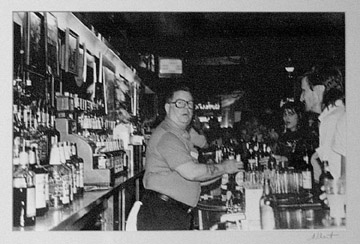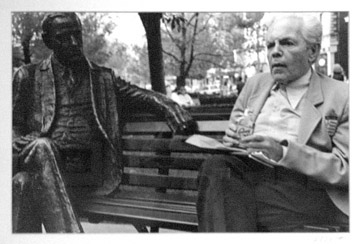Albert Brodsky has been sober for seven years. Outwardly, he appears to be an energetic, talkative man with a talent for photography. Yet, in his artist’s statement he describes a life that seems impossible to equate with the person he is now. “During those years I managed to graduate from the University of Massachusetts and go on to a professional photography school. I owned and operated a very successful photography business. I lived in a lovely community, with a beautiful family in a beautiful house. I would proceed to drink it all away along with all my hopes and dreams. I became homeless, unemployable and on the verge of suicide.
“If my work speaks of anything it is crying out to say ‘be aware of the power and danger of alcohol’…It can rob you of all your goals and ambition,” he pleads. Sponsored by University Health Services and the Alcohol and Addiction Center, this UMass alumnus wants to use his experiences to teach others through his photographic display, that may be found on the fifth floor of Healey Library running until September 30, 2003.
At first, the photos seem fairly run-of-the-mill. It could be the album of any alum’s college years with the random settings of apartments, bars, and diners. Their faces are smeared with laughter and their muscles are relaxed from recent or ongoing inebriation. It should be fun to remember the good times right?
The progression of random photos, though culled from a collection started in 1984, have their own emotional chronology reflected in the pseudo-balance of happy drunks spanning one wall and glassy-eyed indigents on the other. Brodsky’s pictures begin with happy, college-aged kids whose antics range from standard smiles to silly grins. It’s apparent enough that everyone is having a good time.
The opposite wall is filled with age, where the good cheer appears to have seeped out into the shadows, leaving only grim, lined faces whose lips seem to be caught in mid-slur. One man even covers his face. These photos continue on the theme of loss that has moved from earlier photos of many shades of gray, to those laden with darkness, a deliberate choice on the part of the photographer.
The transition to homeless men sleeping around well-known historical sites of Boston is abrupt but not surprising. Though the story is linear and by no means uncommon, its harsh, blunt reality is what makes it seem more painful than most. In that manner is the viewer forced to confront the formerly faceless, myriad members of the homeless. They can no longer be ignored when placed into the context of the exhibition, bottles covertly peeking out of a brown paper sack or cradled between the slumped shoulders of a sleeping drunk. Awash in shadows, it appears to be eerily appropriate for the near twilit aspect of the lighting used because we have simultaneously reached the end of the exhibition and made the trek through the torturous after-effects of alcohol abuse.
However, the last photo is the most captivating and slightly ominous. It’s a single photo of two park benches, side by side, that front the cemetery of King’s Chapel, where Paul Revere is buried. It’s the first real break in his stream of homeless subjects. The bare bench is only covered with a human shadow, Brodsky’s own, that gives rise to an eerie foreshadowing effect. There is no written ending, just a blank slate.
When asked about this photo, Brodsky laughed and said it was taken at 6am in the morning because he liked the shadows of the cemetery and the benches together. It was in retrospect that he felt it was an appropriate ending. The heavy, fateful finality to the photograph was not what he intended. He wants college students to understand that there is a consequence. “I’m trying to use it as an educational tool. The end is the end. You have to be responsible. It’s the journey to the end that’s important.”






















































